Health
Back Clinic Health Team. The level of functional and metabolic efficiency of a living organism. In humans, it is the ability of individuals or communities to adapt and self-manage when facing physical, mental, psychological, and social changes in an environment. Dr.Alex Jimenez D.C., C.C.S.T, a clinical pain doctor who uses cutting-edge therapies and rehabilitation procedures focused on total health, strength training, and complete conditioning. We take a global functional fitness treatment approach to regain complete functional health.
Dr. Jimenez presents articles both from his own experience and from a variety of sources that pertain to a healthy lifestyle or general health issues. I have spent over 30+ years researching and testing methods with thousands of patients and understand what truly works. We strive to create fitness and better the body through researched methods and total health programs.
These programs and methods are natural and use the body’s own ability to achieve improvement goals, rather than introducing harmful chemicals, controversial hormone replacement, surgery, or addictive drugs. As a result, individuals live a fulfilled life with more energy, a positive attitude, better sleep, less pain, proper body weight, and education on maintaining this way of life.

by Dr Alex Jimenez DC, APRN, FNP-BC, CFMP, IFMCP | Athletes, Health
With the competitive season looming, chiropractor Dr. Alexander Jimenez�gives insights & examines the current best thinking on vaccination for athletes, and makes recommendations for sports clinicians.
Without doubt, vaccination is one of the greatest triumphs of modern medicine. Many serious diseases that used to routinely maim or kill large numbers of people are no longer a threat. More than that, vaccination can prevent outbreaks of less serious illness, which although not life threatening, are still unpleasant, leading to missed time from work and school.
Anyone with young children or who has travelled extensively abroad will (hopefully) understand that a programme of vaccination is either required or recommended. When it comes to the travelling athlete however, the situation is rather more complex. While the basic vaccinations (eg typhoid, hepatitis etc when travelling to certain regions of the tropics) are of course still required, clinicians will also want to ensure that their athletes stay as well as possible to compete at their full potential. A mild illness that is an inconvenience to a tourist may be a disaster for an athlete focusing on the peak of his/her season!
Sports clinicians may therefore wish to consider extra vaccinations to minimise the risk of more minor conditions. However, this approach raises a whole new set of issues. For example, which additional vaccinations may be use for athletes who regularly travel abroad? What are the possible side effects of these extra vaccinations and how should vaccines be timed to maximise immunity during the competition, while minimising disruption to training in the run up to competition?
Athletes Are Different
There exists some uncertainty about the most appropriate vaccination regimens in athletes among team doctors and other physicians because general public health vaccination guidelines cannot be easily transferred to elite athletes. Complicating factors include the typical circumstances of athletes� daily life, such as frequent travelling to foreign countries or close contact with teammates and opponents, which might indicate the need for a modification of recommended vaccination schedules. In addition, intense physical activity of training and competition with its possible effects on the immune function can affect decisions about execution and timing of vaccination.
Other complicating factors are that vaccination recommendations are formulated around a public health policy rather than for specific individuals and are likely to change over time(1-3). Also, there�s the issue of cost effectiveness; the majority of vaccines that are not generally recommended are not recommended because the medical benefit is not regarded sufficiently balanced with the costs if implemented across the whole population. This is despite the fact that they may be potentially beneficial in specific individuals(4,5). It�s also important to understand that generalised recommendations take no account of the implications of the effects of illness in athletes, which can be far more profound and far reaching than in the general public (see Box 1).
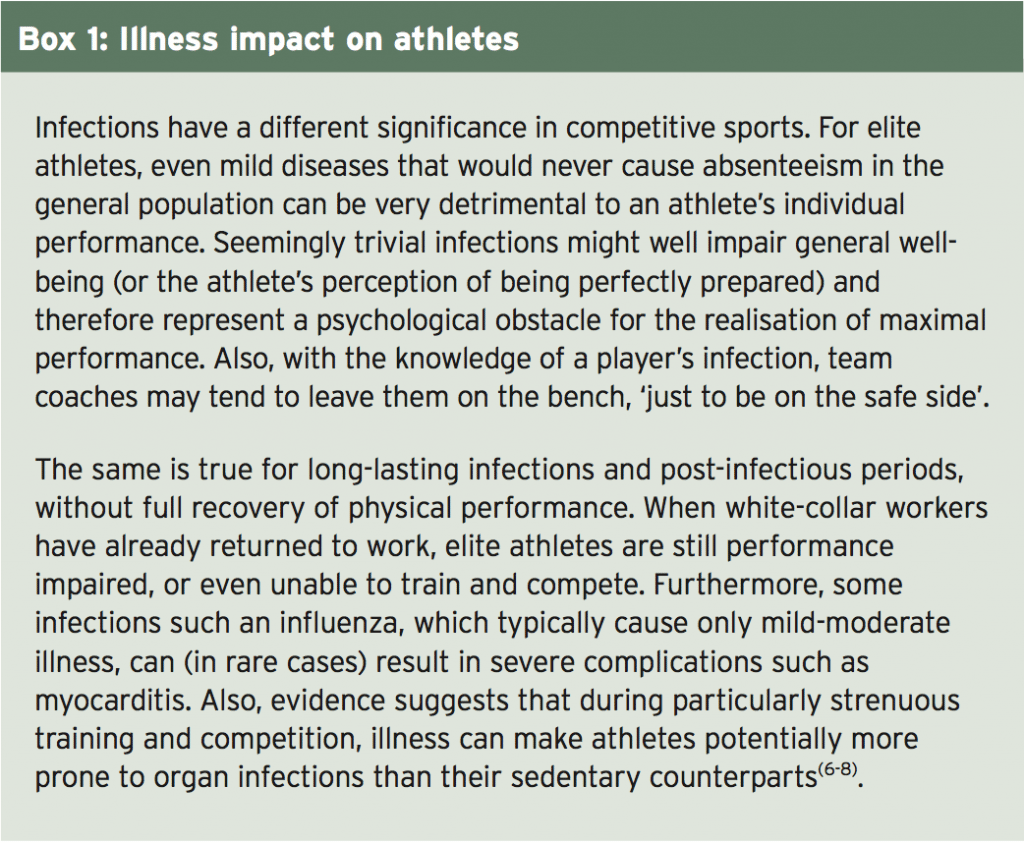
Further reasons as to why athletes are different when it comes to vaccination include the following:
- Athletes are often in close contact with opponents and teammates, which increases the risk of transmission of many diseases, particularly respiratory- transmitted diseases(9,10). Typically, a contact of less than 1-2 metres distance is necessary to transmit diseases such as influenza or other respiratory- transmissible agents such as varicella(11,12).
- For blood-borne diseases, the transmission risk due to sport is less pronounced but athletes are still at higher risk than the general population(13,14).
- Even healthy non-vaccinated athletes being exposed to an infectious agent (eg contact with a diseased individual) may have to be excluded from training and competition for medical reasons. Usually, such an exclusion has to last for the complete incubation period of a disease, which may be up to three weeks.
Putting all these factors together, the recommendation is that elite, competitive athletes should be vaccinated more aggressively than the general public(15).
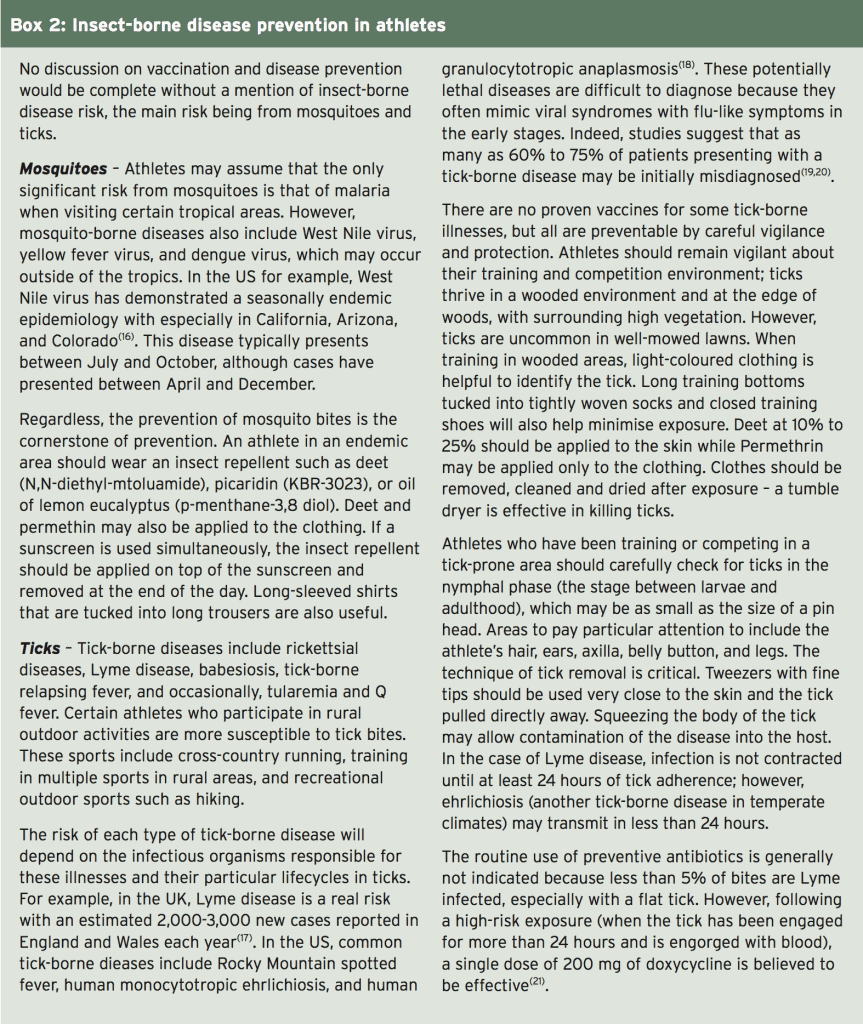
Which Vaccinations?
The decision as to which vaccinations are given prior to foreign travel will depend on a number of factors, including the travel�destination(s), the nature of the sport and the health/vaccination history of the individual involved. Regardless of these factors however, it is recommended that ALL adult athletes are routinely vaccinated against the following:
1. Tetanus
2. Diphtheria
3. Pertussis (whooping cough)
4. Influenza
5. Hepatitis A and B
6. Measles, mumps and varicella (if immunity is not already proven by a natural infection)
Of these, numbers 1-5 should be given as inactivated vaccines while measles, mumps and varicella (chickenpox) should be given as live vaccines(15). A full discussion on the detailed considerations regarding each and every possible vaccination is beyond the scope of this article (readers are directed to a full and recent review of this topic by Luke and D�Hemecourt(15)). However, Table 1 summarises most of the key recommendations.
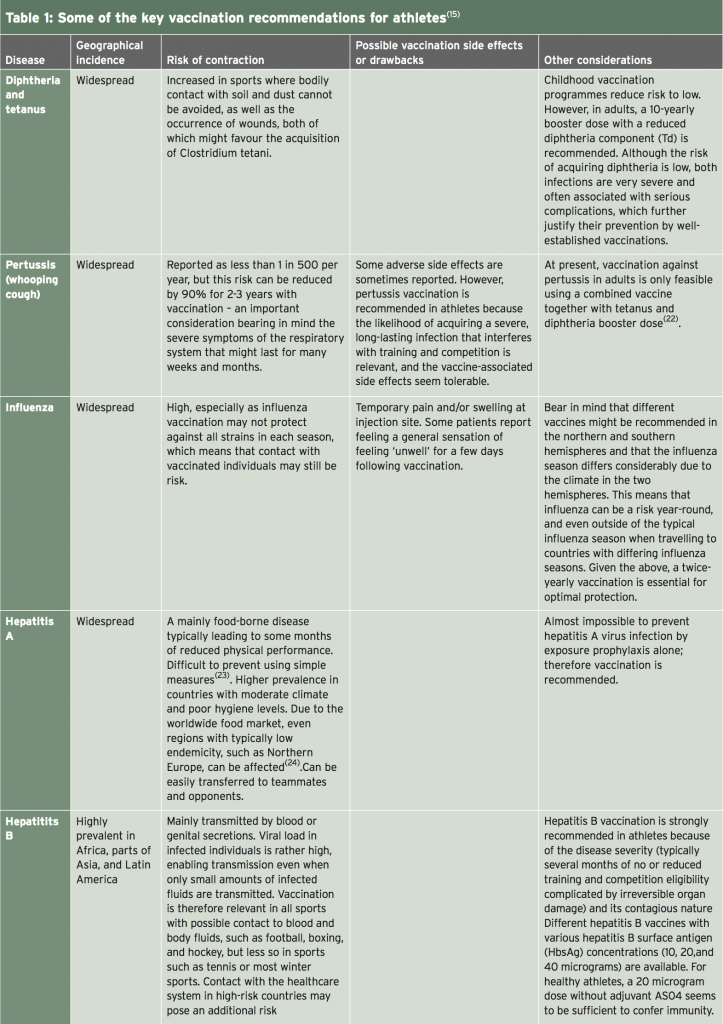
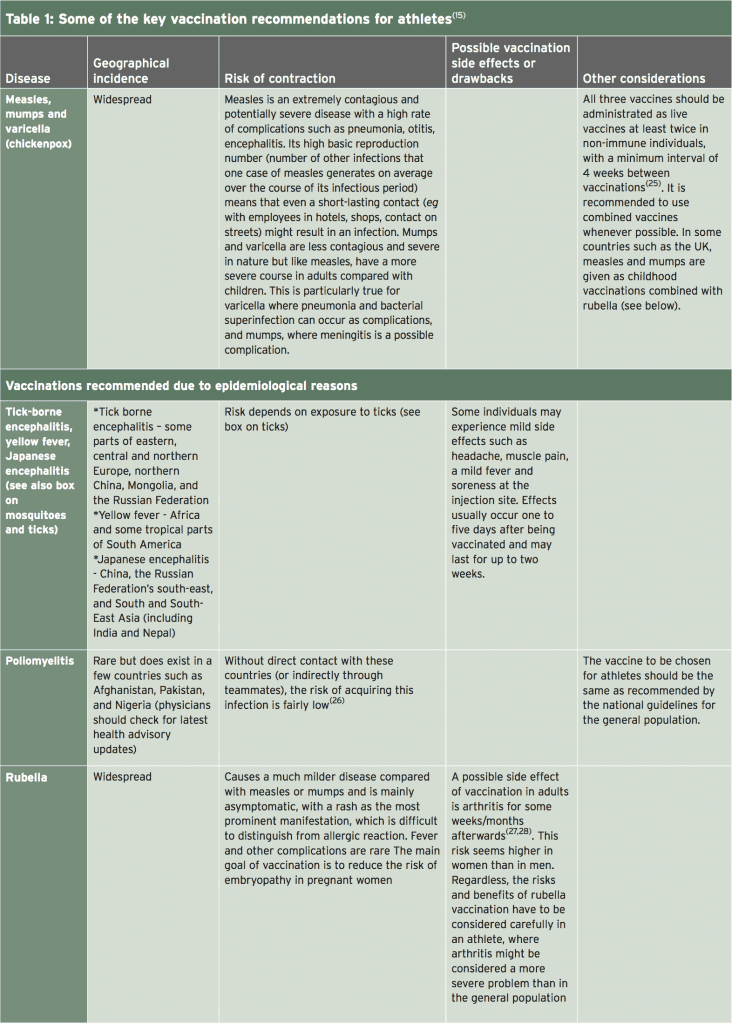
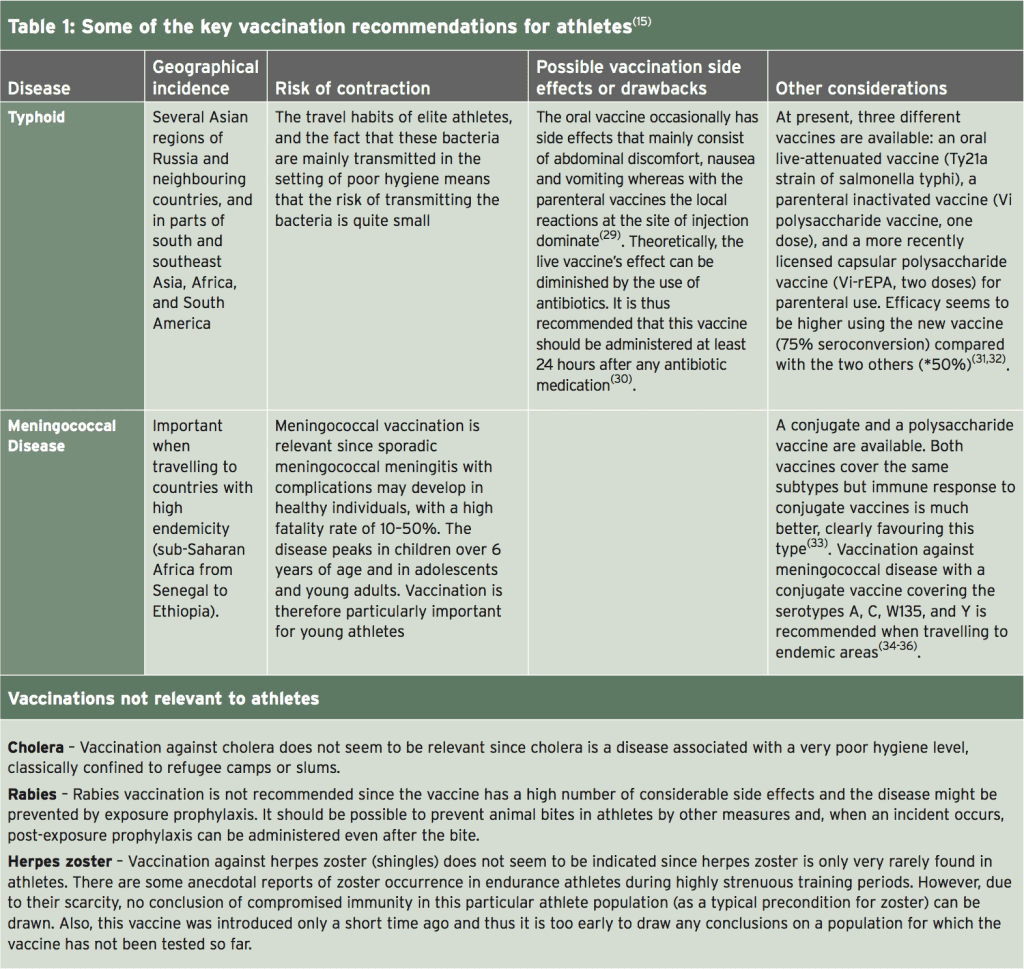
Vaccination Timing
Timing of vaccinations should be chosen in order to minimise interference with training and competition, and to ensure the immune reaction is not temporarily impaired. Inactivated vaccines generally cause side effects within two days following vaccination. This is in contrast to live vaccinations where the peak of side effects is most likely to occur after 10-14 days when replication of the vaccines is at a maximum. Unless a vaccination needs to be administered urgently, the best time therefore for vaccination is at the onset of resting periods � for example at the beginning of the winter off season.
When a vaccination has to be carried out within a training and/or competition period (eg influenza), there is no major medical problem with training undertaken shortly before or after vaccination. However, it is recommended to vaccinate shortly after a competition in order to make the period of time to the next competition as long as possible. Many vaccinations given via injection can cause local pain and inflammation at the injection site. Clinicians may therefore wish to time vaccine administration so as to not coincide with delayed onset muscle soreness (DOMS) following strenuous exercise.
Vaccination Techniques
Dependent on the injection site, some sport- specific impairments may result (for example buttock pain in runners following a gluteal injection). Obviously, it is advisable to use the non-dominant side for injections in unilateral disciplines such as racquet sports. For vaccines that can be administered using either the intramuscular or the subcutaneous route, the intramuscular option seems to be preferable as it yields higher titer rate (more antibody production) and a lower risk of granuloma.
Injection into the deltoid muscle is preferred if possible, although other muscle sites are possible. Regardless, it is important that the athlete is sitting or lying, and the muscle is completely relaxed. Studies indicate that the use of longer needles (25 mm) and a fast speed of injection/ withdrawal of the needle (1-2 seconds) are associated with less pain(37). Also, an angle of injection of 90 degrees may also help reduce pain in intramuscular injections.
Syncopes or collapses following vaccination are uncommon but may occur; some studies on influenza vaccination suggest the frequency of syncope in younger athletes to be around 1%(38). However, the syncope itself may be less important than secondary injuries caused by the collapse such as skull fracture and cerebral haemorrhage. Given that the majority of syncopes (80 %) occur within 15 min of vaccine administration, it is recommended that athletes are observed for a period of 15-30 minutes following vaccination. This recommendation may be particularly important for endurance athletes because there are indications that, in these athletes, vasovagally-induced syncopes are more frequent(39).
Vaccination Schedule
The recommended vaccination schedules for disease prevention will be dependent on the previous vaccination record and disease history of the athlete in question. Also, some schedules are dependent of the type/brand of vaccines used and recommendations may also differ according to public health policy in each country. Readers are directed to the summary given by Luke and D�Hemecour(15); there are also some excellent downloadable resources on the US Centre for Disease Control and Prevention (CDC) � https://www.cdc.gov/vaccines/ schedules/hcp/adult.html.
Summary
The vaccination requirements for elite athletes are not the same as that for the general public. Not only are these athletes�potentially exposed to more disease pathogens as a result of international travel, even the mildest episode of illness that would be barely noticeable to most of us can be devastating for elite athletic performance. For these reasons, sports clinicians and doctors should take a much more aggressive approach to vaccination of their athletes. Together with steps to reduce exposure and the correct vaccination techniques and timing, clinicians can maximise the potential of their athletes to perform at all times of year across all regions of the globe.
References
1. World Health Organization. WHO vaccinepreventable
diseases: monitoring system. 2012
global summary 2013. http://www.who.int/
immunization_monitoring/data/data_subject/
en/index.html accessed 5th Feb 2017
2. Sta�ndige Impfkommission (STIKO).
Empfehlungen der Sta�ndigen Impfkommission
(STIKO) am Robert Koch-Institut. Epi Bull.
2012;283�10
3. Centers for Disease Control and Prevention.
General recommendations on immunization�
recommendations of the Advisory Committee
on Immunization Practices (ACIP). MMWR
Recomm Rep. 2011;60:1�64
4. Vaccine. 2013;31:6046�9
5. Pharmacoeconomics. 2005;23:855�74
6. J Exp Med. 1970;131:1121�36
7. Am Heart J. 1989;117:1298�302
8. Eur J Epidemiol. 1989;5:348�50
9. Clin J Sport Med. 2011;21:67�70
10. Sports Med. 1997;24:1�7
11. J Infect Dis. 2013;207:1037�46
12. Lancet. 1990;336:1315
13. Br J Sports Med. 2004;38:678�84
14. Clin Sports Med. 2007;26:425�31.
15. Sports Med 2014; 44:1361�1376
16. Vector Borne Zoonotic Dis 2004;4(1):61�70
17. http://www.nhs.uk/Conditions/Lymedisease/Pages/Introduction.aspx#symptoms accessed Feb 2017
18. J Infect Dis 1999;180(3):900�3
19. Ann N Y Acad Sci 2003;990: 295�30
20. J Infect Dis 1984;150(4):480�8
21. N Engl J Med 2001;345(2):79�84
22. Pediatrics. 2013;131:e1716�22.
23. Euro Surveill. 2005;10(6):E050609.2
24. Euro Surveill. 2013;18(7):20467
25. Centers for Disease Control and
Prevention. Epidemiology and prevention of
vaccine-preventable diseases. The pink
book:course textbook. 12th ed.; 2012.
26. World Health Organisation. Poliomyelitis;
2014. http://www.who.int/topics/poliomyelitis/en/
27. Clin Exp Rheumatol. 2001;19:724�6
28. JAMA. 1997;278:551�6
29. Clin Infect Dis. 2004;38:771�9
30. Travel Med. 1998;5:14�7
31. Cochrane Database Syst Rev.
2014;1:CD001261
32. Curr Opin Infect Dis. 2012;25:489�99
33. Drugs. 2013;73:1147�55
34. Hum Vaccin Immunother. 2014;10:995�1007
35. Popul Health Metr. 2013;11:17.
36. Vaccine. 2009;27(Suppl 2):B51�63
37. Arch Dis Child. 2007;92:1105�8
38. Vaccine. 2013;31:6107�12
39. Prog Cardiovasc Dis. 2012;54:438�44

by Dr Alex Jimenez DC, APRN, FNP-BC, CFMP, IFMCP | Chiropractic, Health, Med-Legal Corner
Ohio Attorney General Mike DeWine is suing five makers of opioid painkillers for their role in the state’s opioid epidemic.
The suit, which DeWine said is the second by a U.S. state, after Mississippi, claims the drugmakers violated multiple state laws, including the Ohio Corrupt Practices Act, and committed Medicaid fraud.
Purdue Pharma, Johnson & Johnson and its Janssen Pharmaceuticals unit, Teva Pharmaceuticals and its Cephalon unit, Endo Health Solutions and Allergan are all named in the suit.
“In 2014 alone, pharmaceutical companies spent $168 million through sales reps peddling prescription opioids to win over doctors with smooth pitches and glossy brochures that downplayed the risks” of the medicines,” DeWine said at a press conference Wednesday. Last year, he said, 2.3 million people in Ohio, or about a fifth of the state’s population, were prescribed opioids.
In a statement, a spokesman for Purdue Pharma, which manufactures OxyContin, said the company shares the attorney general’s concerns about the opioid crisis and that it is “committed to working collaboratively to find solutions.”
“OxyContin accounts for less than 2% of the opioid analgesic prescription market nationally, but we are an industry leader in the development of abuse-deterrent technology, advocating for the use of prescription drug monitoring programs and supporting access to Naloxone � all important components for combating the opioid crisis,” he said.
Allergan declined to comment, as did a Teva spokeswoman, who said, “We have not completed review of the complaint.”
J&J’s Janssen unit said the company believed the allegations in the lawsuit were “both legally and factually unfounded.”
“Janssen has acted appropriately, responsibly and in the best interests of patients regarding our opioid pain medications, which are FDA-approved and carry FDA-mandated warnings about the known risks of the medications on every product label,” said Jessica Castles Smith, a Janssen spokeswoman.
Endo officials weren’t immediately available to comment.
The Ohio action follows suits from counties and cities seeking to hold accountable the industry that produces, markets and distributes opioid painkillers. DeWine said the Ohio suit, filed Wednesday morning in Ross County, “would compel these companies to clean up this mess through several remedies,” including an injunction to stop “continued deception and misrepresentation in marketing,” damages paid to the state for money spent on the crisis, and repayment to consumers.
Sales of prescribed opioids � including oxycodone, hydrocodone and methadone � almost quadrupled in the U.S. between 1999 and 2015, according to the Centers for Disease Control and Prevention, contributing to a more than quadrupling of deaths from prescription opioids in that same period. Almost 2 million Americans either abused or were dependent on prescription opioid painkillers in 2014, according to the CDC.
In March, attorneys representing two West Virginia counties filed federal lawsuits against drug distributors, including AmerisourceBergen, McKesson and Cardinal Health, accusing companies of violating West Virginia law and threatening public health for distributing huge amounts of opioids in the state.
The city of Everett, Washington, sued Purdue Pharma earlier this year, accusing the drugmaker of gross negligence and seeking payment for the costs of handling opioid addiction.
And three counties in New York sued pharmaceutical companies including Purdue, Johnson & Johnson, Teva and Endo in February, also seeking damages.
Ohio and West Virginia are among the states hardest hit by the opioid epidemic. The crisis has been named by new Food and Drug Administration Commissioner Dr. Scott Gottlieb as a top priority.
“We understand what we’re taking on: five huge drug companies,” DeWine told reporters Wednesday. “I don’t want to look back 10 years from now and say we should have had the guts to file. � It’s something we have to do.”
Source:
CNBC.com
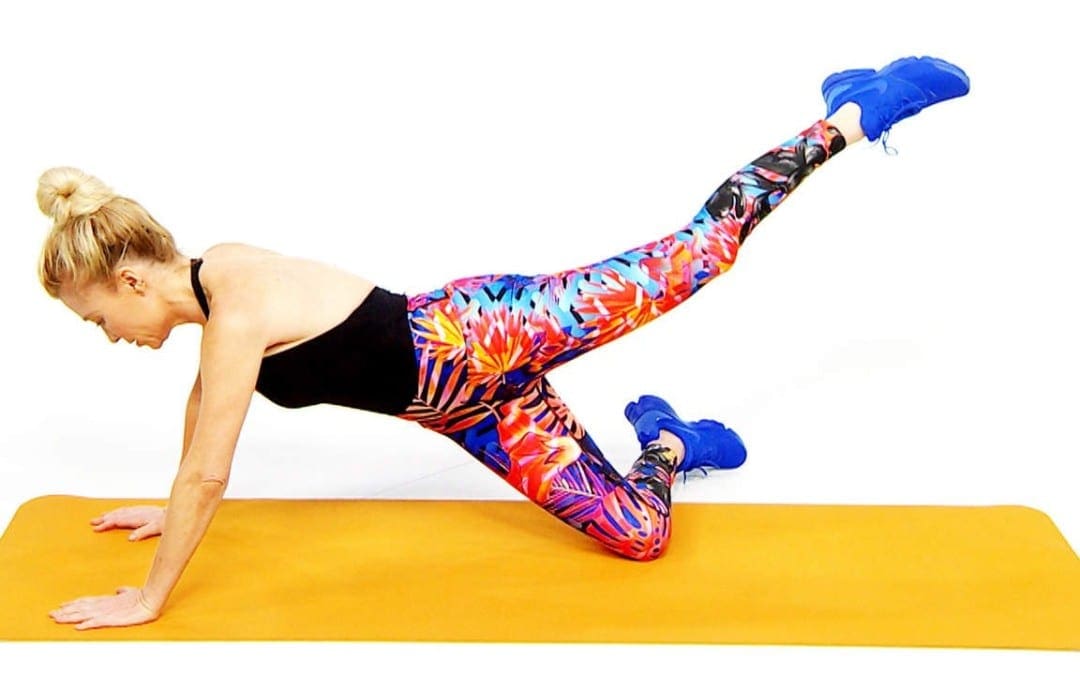
by Dr Alex Jimenez DC, APRN, FNP-BC, CFMP, IFMCP | Fitness, Health, Wellness
When the weather starts getting warmer, most of us immediately ramp up our ab and glute exercises. But what about your arms? Here, Health’s contributing fitness editor Tracy Anderson demonstrates a challenging arm workout you can do anywhere—no equipment necessary.
WATCH THE VIDEO: 5-Minute Hotel Room Workout for Arms, Shoulders, and Back
Tracy notes that the key to strong arms is all about working different parts, not just isolated areas. These bodyweight exercises offer incredibly challenging resistance to get your shoulders, biceps, and triceps in shape for summer. Watch this video to see six of Tracy’s favorite arm-sculpting moves.
No time to watch? Here’s a breakdown of the workout:
Move 1: Start by lying on the ground. Push up into a plank position, then twist your body, creating an award pushup position. Press back up into a full plank and extend your top leg. Lower your body down and extend your leg up again. Do this 30 times. You’re going to start to feel your back arm really working, because you’re twisting your body weight to the back arm, while the front one is just stabilizing. Be sure to do both sides.
Move 2: Get into a full plank position, then straighten one leg to the back. Lift one leg and dangle your knee. Tuck it in towards your chest, then cross it over your other leg, and extend your leg into the air behind you.
Move 3: Get into a plank position. Alternate bringing your knees underneath your body, crossing diagonally, and tapping your knee with the opposite hand. Use your arms to stabilize yourself during this move.
Move 4: Get into a tabletop position. Reach one arm into the sky while pushing your hips up. Twist your body down into a high plank, then press your outside leg up into the air.
Move 5: Get into a plank position. Bend your knee and rest your outer leg on the ground in a twisted position. From here, lift your knee up and extend it out behind you. Keep twisting, lowering, and lifting for 30 reps.
Move 6: Get into a wide leg plank. Lower down to one forearm, then switch to the other. Next, energetically push your body back up using just one arm.
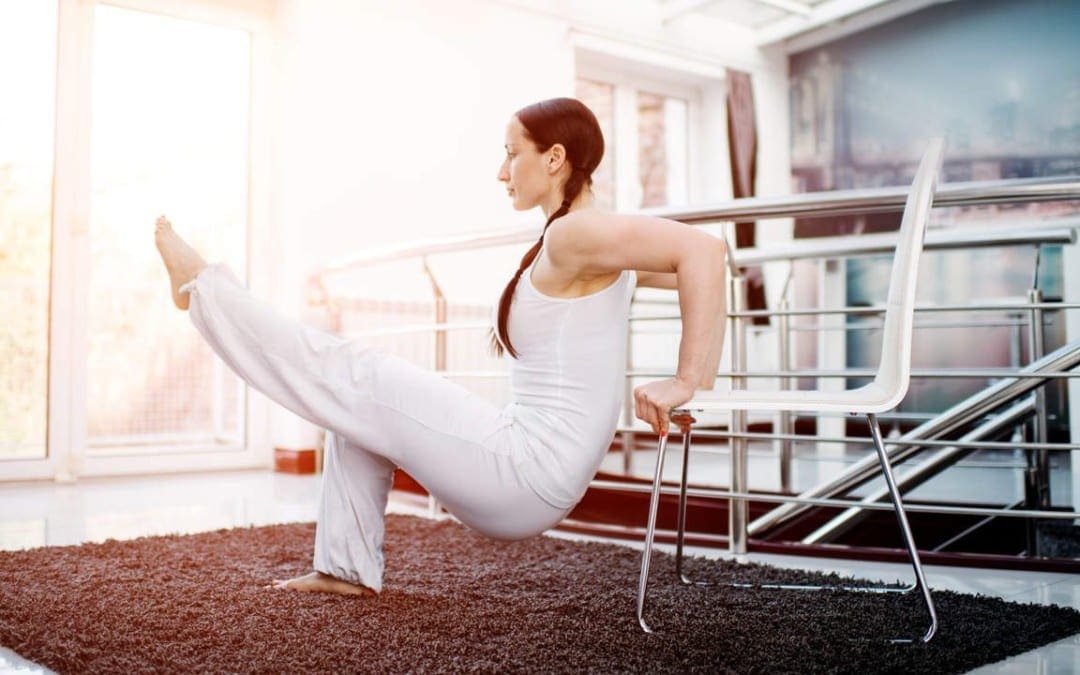
by Dr Alex Jimenez DC, APRN, FNP-BC, CFMP, IFMCP | Fitness, Health, Wellness
It’s no secret that sitting at a desk all day isn’t good for you. A sedentary lifestyle can lead to weight gain, which may then lead to a host of other issues. Research has shown that sitting too much throughout the day can lead to a number of different health problems, including obesity, heart problems, and diabetes.
However, there are things you can do to offset the health risks of sitting at your desk, such as getting up to take frequent walks. But even if you can’t leave your chair, there are even plenty of movement exercises you can do right from your desk, such as chair yoga. You could also take advantage of the time to work on some mobility training—a form of exercise that focuses on improving your stability, range of motion, and loosening your muscles so you can perform better during any workout.
Frank Baptise, founder of Frankly Fitness, is a big fan of mobility training as an effective way to help promote healthy joints, balance, and flexibility in your body. Here, he demonstrates six simple yet effective moves to try at your desk. All you need is a stress ball and a desk chair!
Don’t have time to watch? Here’s a quick rundown of Baptiste’s go-to mobility moves:
Glute and piriformis: self-myofascial release
Roll and apply pressure. Hold for 5-10 deep breaths.
Peck roll
Roll and apply pressure. Hold 5-10 deep breaths.
Plantar fascia roll
Roll and apply pressure. Hold for 5-10 deep breaths.
Modified chair downdog
Hold for 3 breaths. 3-5 reps.
Modified lunge with rotation
Hold for 3 breaths. 3-5 reps each side.
Figure four squat
Hold for 3 breaths. 3-5 reps each side
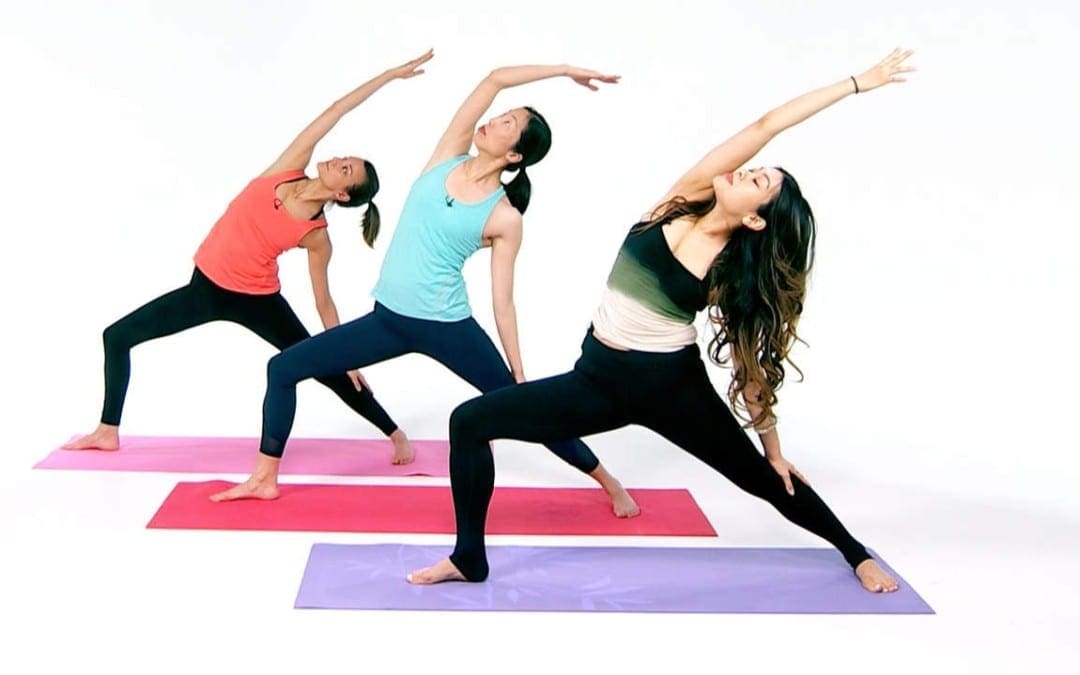
by Dr Alex Jimenez DC, APRN, FNP-BC, CFMP, IFMCP | Fitness, Health, Wellness
Feeling stressed? On any given day, you’re likely bombarded with many different stress-inducing situations. Perhaps it’s a challenging project at work, a fight with your partner, or just someone who unapologetically bumped into you on the street.
Life is filled with challenges and frustrations like these. But the good news is there are plenty of smart strategies that can help you refocus your energy so you feel calm and peaceful instead of frazzled. Take meditation and mindfulness, for example—both practices are all about checking in with yourself and filtering stress out of the mind. And if meditation isn’t your thing, exercise is also a great way to help release your daily frustrations and send a healthy dose of feel-good endorphins to your brain.
WATCH THE VIDEO: A 5-Minute Meditation to Help You Find Your Calm Now
Better yet, combine two of these mindful practices: meditation and exercise. Yoga is perfect for this, especially if it’s a calming flow that can quiet your mind while simultaneously strengthening your muscles. By forcing you to pay close attention to your breath, yoga helps stop your racing thoughts.
Watch this video for a calming 10-minute yoga flow from Kirby Koo of Yoga With Kirby. It focuses on the importance of your breath, so you can calm your mind and banish stress.
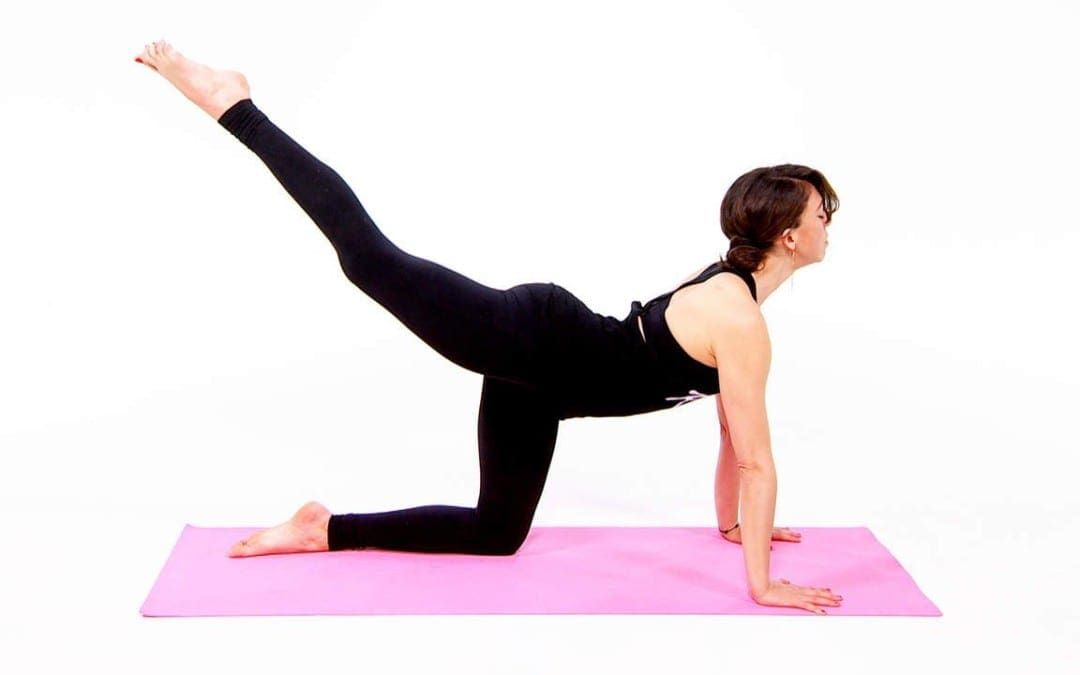
by Dr Alex Jimenez DC, APRN, FNP-BC, CFMP, IFMCP | Fitness, Health, Wellness
Anyone who struggles with back pain knows how distressing it can be. Whether it�s soreness that impedes your sleep or aches that hurt your productivity while you sit at your desk at work, back pain is hard to ignore no matter what position you�re in.
The good news? Yoga can be a surprisingly helpful remedy. In this video, yoga expert and Retox author Lauren Imparato takes you through a 20-minute yoga flow designed to soothe and prevent back pain. Yes, please!
�How you sit, how you sleep, something you ate, how you moved,� can all contribute to upper or lower back issues, Imparato explains. And while treatment options do exist�such as massage and acupuncture�studies have shown that yoga may actually be more effective than these and other alternatives. Research from the Annals of Internal Medicine found that people with chronic lower back pain saw more improvement of their symptoms after a 12-week yoga class compared to those who only received medicine or physical therapy to treat their pain.
RELATED: 4 Surprising Cures for Back Pain
Want to experience the same relief? In this video, Imparato will first help you release tightness and tension in your back by guiding you through classic stretches like cat and cow. Next, she�ll show you how to do a quick, equipment-free flow that works to stabilize the spine and strengthen the muscles in your core that support it. (Hi, toned abs!) Watch the clip above for a yoga routine that not only reduces back pain but crafts long, lean muscle at the same time.
Also check out our sister company: Best Yoga Routines for Sleep. �This is a great article that helps you doze off…. WAY Better…
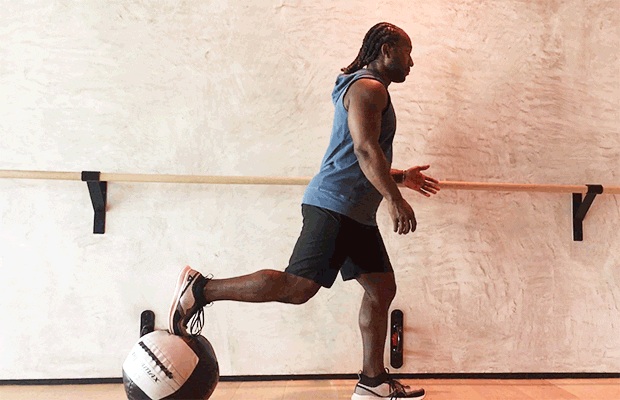
by Dr Alex Jimenez DC, APRN, FNP-BC, CFMP, IFMCP | Fitness, Health, Wellness
Photo: Twenty20
This is a partial workout. You can find the rest of the moves at Life by Daily Burn.
When you look at a slam ball, leg and glute exercises may not be the first thing that comes to mind. But incorporating this soft weighted ball into your booty routine will work your lower half hard. Weak hamstrings, glutes and hips can lead to knee and back pain. So if you’re looking for a way to strengthen these muscles, while building power, the slam ball can kill two birds with one big, squishy ball.
Gerren Liles, PROJECT by Equinox master trainer and Reebok ONE Elite ambassador likes to use it for a quick leg workout. “The slam ball is a simple tool that allows you to move in multiple dimensions and directions, and can serve as a load to develop strength and power,” Liles says.
In addition to tightening and toning, the slam ball creates an unstable environment that forces your body to work harder to balance weight. (Stability challenge, anyone?) And because you’ll move in different planes of motion, you’ll work your core, legs and arms, too.
“The ball can be used as a prop to challenge your stability, as you’ll see in the Bulgarian squat and soccer tap drill. It can also be used as a form of resistance in the squat with front push and hamstring curls,” Liles explains. Check out just how versatile this space-efficient piece of equipment can be in the six exercises below.
RELATED: The 30-Minute Slam Ball Workout
6 Slam Ball Exercises That Build Lower-Body Strength
These moves will not only blast your lower half, they’ll help improve your ankle mobility, agility and reflexes. Add some intensity, and they’ll get your heart rate up, too, Liles says. Do 8 to 10 reps of each exercise for two sets.
GIFs: Tiffany Ayuda / Life by Daily Burn
1. Bulgarian Squat
This variation of the squat challenges your balance. To keep your foot from rolling off the ball, engage your core so you can move with more control, Liles says.
How to: Stand with your feet together in front of a slam ball. Step your right foot back and place your toes on top of the ball (a). Keeping your weight in your left heel, slowly lower your body into a lunge, bending your right knee towards the floor. Your left knee should form a 90-degree angle to the floor. Be sure your left knee is stacked above your ankle (b). Straighten both legs and return to standing (c).
RELATED: 6 Squat Variations for Total-Body Strength
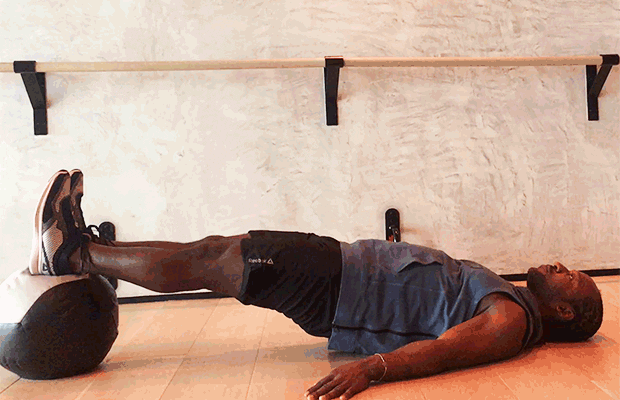
2. Lying Hip Bridge With Hamstring Curl
Take your glute bridges to the next level with this variation that also strengthens your hamstrings. The lack of surface area on the ball is an added challenge to making the movement slower.
RELATED: 5 Exercise Machines That Aren’t Worth Your Time
How to: Lay on your back with your hips lifted off the floor and your calves and heels on top of the ball. Plant your hands on the floor at your sides (a). Draw your heels in toward your butt with control, bending your legs. Your hips should elevate even higher as you squeeze your glutes to bring your heels in (b). Slowly extend your legs back out to the starting position (c).
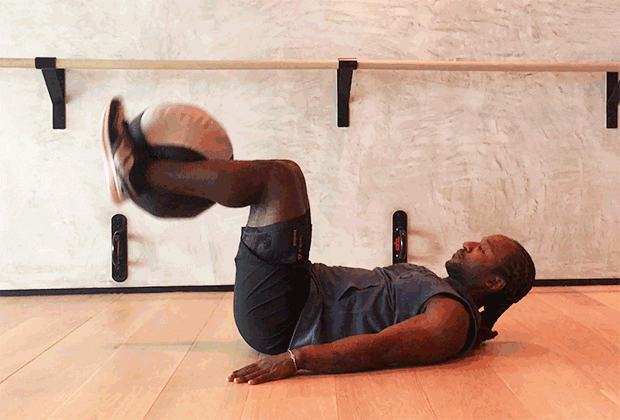
3. Lying Quad Extension
Your quads, hamstrings and glutes are some of the biggest muscles groups in your body. This simple move fires up all three, helping you torch more calories per workout.
How to: Lie flat on your back and place the ball between your calves with your knees bent. For an added core challenge, you can lift your head off the floor and bring your chin towards your chest (a). Without moving your hips, bring your legs straight up towards the ceiling (b). Then, bend your knees until the ball touches the back of your legs. Remember to press your low-back into the floor throughout the entire movement (c).





















